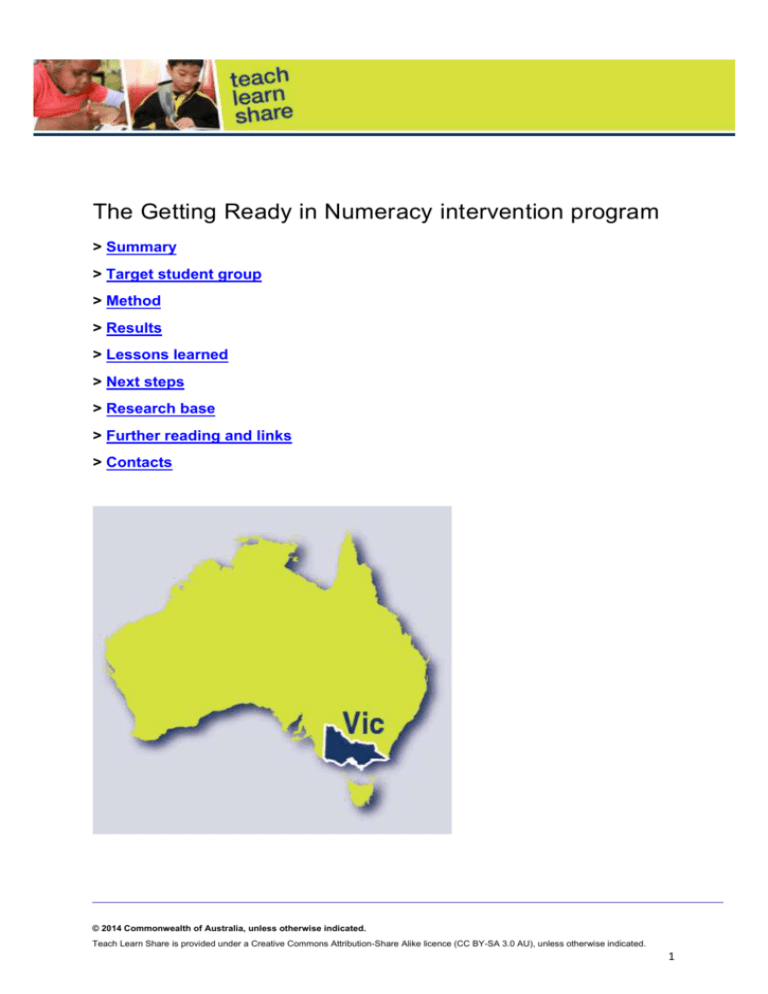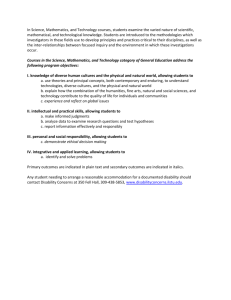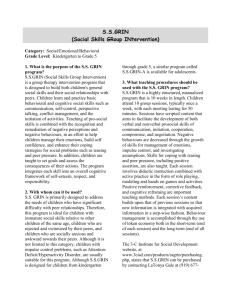The Getting Ready in Numeracy intervention program
advertisement

The Getting Ready in Numeracy intervention program > Summary > Target student group > Method > Results > Lessons learned > Next steps > Research base > Further reading and links > Contacts © 2014 Commonwealth of Australia, unless otherwise indicated. Teach Learn Share is provided under a Creative Commons Attribution-Share Alike licence (CC BY-SA 3.0 AU), unless otherwise indicated. 1 Summary The Getting Ready in Numeracy (GRIN) intervention program involved tutors working with small groups of students who had fallen behind in their numeracy learning, to get them ready for the mathematics classes that they would subsequently attend. The aim was to reduce the cognitive load and give students the confidence to participate in mathematics classes. This program taught students the mathematical knowledge and language they needed to participate in their mainstream maths classes. The class teacher briefed the tutor on the focus and language required for the upcoming classes. The tutor then met with groups of three students to get them ready for those classes. The tutor's objectives for each session were to: familiarise students with the mathematical language and tools required model efficient strategies for dealing with the mathematical concepts present the key mathematical concepts underpinning the work to be covered in the lesson. The tutored students participated fully in the subsequent mathematics classes, which flowed better as a result of the GRIN initiative. Target student group Since 2010, this initiative has been used with about 30 primary and secondary schools across Victoria, targeting roughly ten per cent of the students in those schools. GRIN targeted students from years 2–11 who had fallen a long way behind in their mathematics classes. They included Aboriginal and Torres Strait Islander students and English as a Second Language students. © 2014 Commonwealth of Australia, unless otherwise indicated. Teach Learn Share is provided under a Creative Commons Attribution-Share Alike licence (CC BY-SA 3.0 AU), unless otherwise indicated. 2 Method The program was developed by the Faculty of Education at Monash University, and was implemented in over 30 schools, both primary and secondary. Students were selected after analysing their needs. The targeted students were having difficulty with mainstream mathematics lessons because they lacked basic mathematical understanding and had substantial gaps in their knowledge. Teachers planned their mathematics teaching in advance and told the tutors about the topics. The tutors then worked with a small group of students to prepare them for those classes. Training and a manual were provided to inform the structure of the tutored lesson. The mathematics content for the tutored lessons was drawn from the class mathematics program. The GRIN team also provided specific follow-up support for teachers and tutors once each term. In 2012, one implementation was at Monash University with Aboriginal and Torres Strait Islander adult students. Those students were making the transition to tertiary study, and were required to complete year 12–equivalent mathematics studies. The coordinator of this initiative reported that: Giving students the chance to create a foundation to build on in class has genuinely revolutionised their approach to the unit, and to their studies in general. This approach has markedly reduced students' anxieties and concerns, and has created a far more positive attitude; this has contributed to an overall lift in their confidence and self-belief. Importantly, the shift in approach led to them becoming our first ever cohort of students to pass the maths unit comfortably, achieving distinction averages. Results Students' mathematics learning improved greatly after their involvement in GRIN. Three types of data were collected: quantitative data of student learning as a result of GRIN qualitative data from interviews with teachers of the tutored students, and with the tutors themselves video records of students participating in tutoring sessions. © 2014 Commonwealth of Australia, unless otherwise indicated. Teach Learn Share is provided under a Creative Commons Attribution-Share Alike licence (CC BY-SA 3.0 AU), unless otherwise indicated. 3 Quantitative data were gathered as part of the usual school routines. The schools used the Victorian Curriculum and Assessment Authority (VCAA) On Demand test at the start of each year, and again later in the year. It was an online assessment similar to National Assessment Program – Literacy and Numeracy (NAPLAN), and student scores were given as a Victorian Essential Learning Standards (VELS) level, in which an increase of 1.0 represents two years of progress on the curriculum. Qualitative data were collected through separate interviews with teachers and tutors. Interviews were recorded and examined for common themes. The intention of GRIN was to change students' attitudes towards mainstream mathematics classes, and their teachers were best placed to comment on students' participation. Video records showed students' participation in tutorial sessions. This information provided teachers and tutors with additional information about students' learning. In terms of the general school student assessments, in 2010 the mean gain scores of the 57 tutored students in primary schools were comparable with the gains of the 170 other students. In 2011, from seven primary schools in which there were 65 tutored students and 362 others, the mean gains of the tutored students was 0.53 of a VELS level compared with 0.38 for the non-tutored students. This equated to roughly one-third of a year improvement. Students who had been identified as a long way behind their peers were progressing slightly faster than the non-tutored students. For secondary schools in 2010, 45 tutored students were compared with 254 others. The tutored students in one school improved over the others by around one full year of growth, and in the other school by around one-fifth of a year of growth. In three secondary schools in 2011, there were 21 tutored students and 228 others. The mean gain of the tutored students was .45 of a VELS level, whereas the non-tutored students had a mean gain of –.04 of a VELS level. The tutored students improved by a full year over the others. © 2014 Commonwealth of Australia, unless otherwise indicated. Teach Learn Share is provided under a Creative Commons Attribution-Share Alike licence (CC BY-SA 3.0 AU), unless otherwise indicated. 4 The most significant data attesting to the impact of the initiative was from teachers and tutors. Teachers of Aboriginal and Torres Strait Islander students attest to this: ‘He has auditory processing issues, and often shuts down and gets visibly upset because of the stress of not understanding what's going on. Not because he doesn't want to know, but because, as he said, ''sometimes it's just like blah, blah, blah'' to him because of his auditory issues. With GRIN, having that three-to-one ratio allows him to take it slower. He can actually concentrate more and hear what's being said. So, instead of shutting down in class and getting frustrated and crying, he's able to participate. So that's just the biggest change for him.’ (Classroom teacher) ‘It alleviates some of their stress when it comes to the maths class. When they come into maths classes they're more focused, because they have a sense of what they're going to do’. (Classroom teacher) ‘The confidence of the kids is the biggest thing, hands down. Every one of them, you can see it on their faces. Before the kids were on the GRIN program they weren't disruptive, they just weren't participating.’ (Classroom teacher) Lessons learned The initiative was simple in conceptualisation, and addressed a major challenge that teachers face: how to support students who have fallen a long way behind. In 2012, GRIN was adopted in bridging programs for Aboriginal and Torres Strait Islander students at Monash University, with outstanding success. The implementation of the program at various levels and settings indicated that the increased awareness of the content of mathematics classes – and the willingness of tutored students to participate – contributed to improved mathematics learning outcomes. The challenges were organisational ones, such as finding a location for tutorial sessions and the timing of tutorials. © 2014 Commonwealth of Australia, unless otherwise indicated. Teach Learn Share is provided under a Creative Commons Attribution-Share Alike licence (CC BY-SA 3.0 AU), unless otherwise indicated. 5 One of the benefits was that engagement in the program transferred to the study of other subjects, and to the flow of the mainstream lessons for other students. Teachers commented: 'It flows into other subjects as well. All the teachers have said that the kids are more likely to tune in. They are definitely more positive towards learning in general.' 'It is now easier to teach the whole grade, because those two or three kids are more tuned in to what's going on.' The tutors were also very positive: 'It's great that the kids have the opportunity in GRIN to revisit all the maths they were doing in the classroom. The more one-to-one teaching and the more opportunities they are given to revisit and explore those maths concepts, the better the chance they have of gaining those essential skills.' 'No one in GRIN wants to miss out, so they are making sure they're on time for school. One comes at about eight o'clock in the morning. He doesn't obviously have a great perspective of time yet, but he knows that he has to be here before school starts.' 'We have really good attendance here from both groups. It makes those kids want to be at school on time.' Next steps There will be some organisational challenges for schools in finding locations and times for tutored sessions. Solving these problems is vital for success. Teachers and tutors need to be trained in the principles of the GRIN program, and both groups need ongoing support with routines and communication practices. The initiative is clearly sustainable: ‘In our experience, having completed a year of tutoring, the tutors knew as much about the processes as the designers of the GRIN program. Because the program was about the process of planning and communicating between teachers and tutors, the processes are easy to maintain once the systems are established in schools.’ (School principal) © 2014 Commonwealth of Australia, unless otherwise indicated. Teach Learn Share is provided under a Creative Commons Attribution-Share Alike licence (CC BY-SA 3.0 AU), unless otherwise indicated. 6 Research base Many factors can make mathematics learning difficult for students who have fallen behind. Number sense and fluency with number calculations are vital for classroom participation. Students also need familiarity with the technical terms, an understanding of general language structures, and to be able to recognise subtle differences between related concepts. In addition, the formality associated with setting-out procedures, interpretation of diagrams, use of instruments and diagrammatic representations of manipulatives, increases the complexity of classroom learning for students who are less familiar (or unfamiliar) with these aspects. Students who are not aware of these connections benefit from having them explained. Underpinning the design of GRIN is the well-established explanation of how learning can be made more efficient, referred to as 'cognitive load theory' (Sweller, 1988). Cognitive load theory explains how certain learning principles can be adopted to reduce the load on students' mental resources; this allows students to focus on building connections between what is being taught and what they already know and understand. GRIN focuses on minimising the cognitive load caused by unfamiliar language and inefficient number strategies by presenting key concepts; this increases the likelihood of students making cognitive connections. A complementary aspect of GRIN is preparing students for the social context of the classroom. No one wants to be seen as failing in the eyes of their peers. Many classrooms operate on the assumption that students experiencing difficulty will ask questions of the teacher or peers, but not all students will expose their deficiencies in this way. So, rather than trying and failing, some students misbehave as an alternative way of taking part in the class. The intention of GRIN is that by getting students ready for the class, it will increase the chances that they feel confident enough to answer questions, make suggestions and ask for help if necessary. © 2014 Commonwealth of Australia, unless otherwise indicated. Teach Learn Share is provided under a Creative Commons Attribution-Share Alike licence (CC BY-SA 3.0 AU), unless otherwise indicated. 7 Further reading and links Monash University Faculty of Education 2012, GRIN Program Elements, www.edu.monash.edu.au/research/projects/grin/elements.html Naughtin K & Sullivan P 2012, Getting Indigenous Students Ready for Mathematics Classes. Sullivan, P 2012, Getting Ready in Numeracy, video recording, Monash University Faculty of Education, www.edu.monash.edu.au/research/projects/grin Sullivan P & Gunningham S 2011, A strategy for supporting students who have fallen behind in the learning of mathematics, AAMT and MERGA, www.merga.net.au/documents/RP_SULLIVAN&GUNNINGHAM_MERGA34-AAMT.pdf Sweller, J 1988 'Cognitive load during problem solving: Effects on learning', Cognitive Science, no. 12, pp. 257–285 Sweller, J 2006, 'Why understanding instructional design requires an understanding of human cognitive evolution', in H O'Neil & R Perez (eds), Web-Based Learning: Theory, Research, and Practice, pp. 279–295, Lawrence Erlbaum Associates, Hillsdale, New Jersey Contacts For more information about Getting Ready in Numeracy (GRIN), go to www.edu.monash.edu.au/research/projects/grin or email karen.mcdonnell@monash.edu © 2014 Commonwealth of Australia, unless otherwise indicated. Teach Learn Share is provided under a Creative Commons Attribution-Share Alike licence (CC BY-SA 3.0 AU), unless otherwise indicated. 8



![[#HDCOOKBOOK-37] Support custom feature and allow user](http://s3.studylib.net/store/data/007814789_2-21db60e11fb2407148c3d5f0f777bdab-300x300.png)
